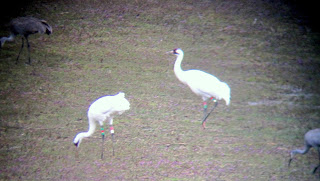I'm in Florida visiting the Chass (Chaz) Pen where 1/2 of the 2010 Ultralight juveniles are staying. Eva, my field supervisor, stays down here every winter monitoring the juveniles after the ultralight team has dropped them off.
When the juveniles reach the pen, they are banded, and given their final health checks. After that, they are free birds! Though, we DO expect them to stay near the pen for safety. It's an open-top pen so they can fly in and out as they choose. We provide food for them at the pen to encourage them to stay close to the location.
Eva has taken me out to the pen a few times. Someone goes out to check on the birds twice a day. It surprises me how much time and effort is spent on the simple act of getting out to the pen.
Step 1: Attach the airboat and check that the airboat works (gas, trailer lights, hull plugs, engine, etc.)
Step 2: Drive the airboat to the boat ramp around twisty-windy roads, and get her on the water!
Step 3: Drive the boat around twisty-windy water passages until eventually we get to Pen Island (as I like to call it)
 | | | |
|
|
|
|
|
|
|
|
|
|
|
|
|
|
|
|
|
|
|
|
|
|
|
|
|
|
|
|
|
|
|
|
|
|
|
|
|
|
|
|
|
|
|
|
|
|
|
|
|
|
|
|
|
|
|
|
|
|
|
|
|
|
|
|
|
|
|
|
|
|
|
|
|
|
|
|
|
|
|
|
|
|
|
|
|
|
|
|
|
|
|
|
|
|
|
|
|
|
|
|
|
|
|
|
|
|
|
|
|
|
|
|
|
|
|
| Pen Island |
|
Step 4: Dock the boat and check water salinity (we monitor this daily to see what environment the birds are exposed to. Whooping Cranes who winter in Aransas, Texas have similar water salinity levels)
 |
| Eva testing Salinity |
Step 5: Walk the twisty-windy-rocky island pathway to the observation blind.
Step 6: Suit up and check on the birds. The 2010 juveniles seemed to know we were there (who can blame them? The super-loud boat arrives before every feeding). They were milling around the pen site when we check them from the blind, and then they flew around a bit before landing inside the pen.
 |
| Juveniles expecting our arrival just outside the pen |
 |
| Flying Juveniles |
Step 7: Let down the buckets so the birds can feed.
 |
| 27-08 gets his own bucket on Monday mornings. |
|
|
|
Step 8: Check the fence and the voltage on the electric fence to make sure the predators stay out.
 |
| This is a great front-view of the blind. |
Step 9: Check the birds before we leave
 |
| Happy Cranes: after stuffing themselves silly, they are preening in the Florida sun. |
Step 10: Return with the boat to our campsite and wash the salt water off the hull and trailer
Notes:
27-08 returned to the pen site a couple weeks ago. He kept guarding the young crane-lings away from the first food bucket, so we set up a second bucket in hopes that he couldn't guard both. Well, we were wrong. He kept running back and forth between the two buckets keeping the chicks away. Eventually, we decided to put up the buckets so he couldn't have any food, thus removing his 'territory.' We let down the buckets when the costume is there to keep 27-08 away from the food and he'll get the occasional handout. This way he'll stick around and hopefully lead the chicks back on their northward migration.









































